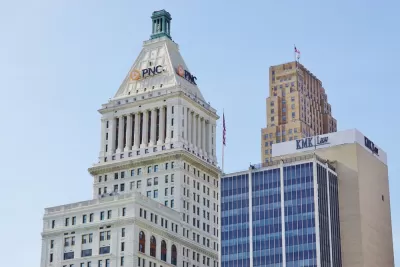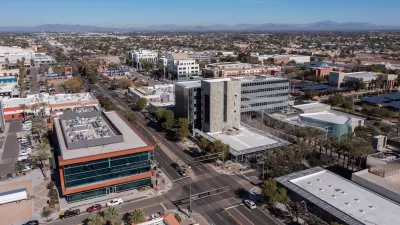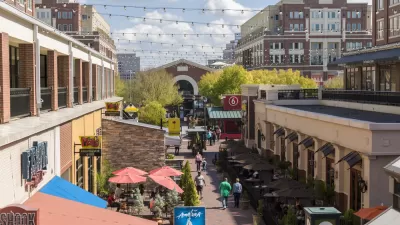The lengths to which the city of Cincinnati should go to attract development investments was up for debate this week.

Nick Swartsell reports on a glut of development subsidies approved by the Cincinnati City Council earlier this week, ranging from an adaptive reuse project that will convert an historic office building to a 262-unit apartment building, a mixed-use development on the riverfront, and many more projects.
"But not everyone is happy about every one of those deals," according to Swartsell. "Some activist groups have objected to the foregone taxes and the lack of affordable housing in the projects. Boosters, however, say they represent valuable opportunities to spur new construction and efforts to rehabilitate significant buildings in the city."
As noted by Swartsell, the largest project is the aforementioned proposal to convert the PNC Tower, built in 1913, into 262 apartments at the cost of $103 million.
"The city has offered a forgivable $2.5 million loan — $1.5 million upfront and another million that will be released later, after the developer makes $9 million worth of facade restorations. Instead of property taxes, the developers would pay into a tax increment financing district created around the building. Eventually, the city would return more than $11 million from that TIF to the developer. The city would keep another $7.75 million. The project has also received federal Historic Preservation Tax Credits."
The Cincinnati Federation of Teachers is one of the leading critics of this development deal, among the others approve this week by the Cincinnati Council. Additional coverage of the deals, and the debate, is also available from an article by Chris Wetterich, written before the council action.
FULL STORY: A Bevy of Cincinnati Development Projects Get Tax Incentives

Study: Maui’s Plan to Convert Vacation Rentals to Long-Term Housing Could Cause Nearly $1 Billion Economic Loss
The plan would reduce visitor accommodation by 25,% resulting in 1,900 jobs lost.

North Texas Transit Leaders Tout Benefits of TOD for Growing Region
At a summit focused on transit-oriented development, policymakers discussed how North Texas’ expanded light rail system can serve as a tool for economic growth.

Why Should We Subsidize Public Transportation?
Many public transit agencies face financial stress due to rising costs, declining fare revenue, and declining subsidies. Transit advocates must provide a strong business case for increasing public transit funding.

How to Make US Trains Faster
Changes to boarding platforms and a switch to electric trains could improve U.S. passenger rail service without the added cost of high-speed rail.

Columbia’s Revitalized ‘Loop’ Is a Hub for Local Entrepreneurs
A focus on small businesses is helping a commercial corridor in Columbia, Missouri thrive.

Invasive Insect Threatens Minnesota’s Ash Forests
The Emerald Ash Borer is a rapidly spreading invasive pest threatening Minnesota’s ash trees, and homeowners are encouraged to plant diverse replacement species, avoid moving ash firewood, and monitor for signs of infestation.
Urban Design for Planners 1: Software Tools
This six-course series explores essential urban design concepts using open source software and equips planners with the tools they need to participate fully in the urban design process.
Planning for Universal Design
Learn the tools for implementing Universal Design in planning regulations.
Ascent Environmental
Borough of Carlisle
Institute for Housing and Urban Development Studies (IHS)
City of Grandview
Harvard GSD Executive Education
Toledo-Lucas County Plan Commissions
Salt Lake City
NYU Wagner Graduate School of Public Service




























